Hi there,
Attached is my current circuitry for an LED strobe light I am creating. I am having problems wiring in a transistor. My circuit consists off 27 LED's wired in series to the Pin 1 output with 220R resistors. I have tried wiring in NPN and PNP transistors (due to lack of current from the pin output) but cannot seem to get the LED's lighting and flashing. Can someone give me a quick run down on how transistors work? I wish to wire it into the part of the circuit between the pin output and the first LED's and have it carrying a positive current to the LED's (resistors and wiring already done etc. so no room for change). Is this possible of is there a better way of acheiving this? It seems that the diagrams I keep finding work based on a negative charge to the transistor, not a positive.
Thanks for any help you can give me
Cheers,
Gareth
Attached is my current circuitry for an LED strobe light I am creating. I am having problems wiring in a transistor. My circuit consists off 27 LED's wired in series to the Pin 1 output with 220R resistors. I have tried wiring in NPN and PNP transistors (due to lack of current from the pin output) but cannot seem to get the LED's lighting and flashing. Can someone give me a quick run down on how transistors work? I wish to wire it into the part of the circuit between the pin output and the first LED's and have it carrying a positive current to the LED's (resistors and wiring already done etc. so no room for change). Is this possible of is there a better way of acheiving this? It seems that the diagrams I keep finding work based on a negative charge to the transistor, not a positive.
Thanks for any help you can give me
Cheers,
Gareth





